Energy Subsidy Reform in the Persian Gulf: The End of the Big Oil Giveaway
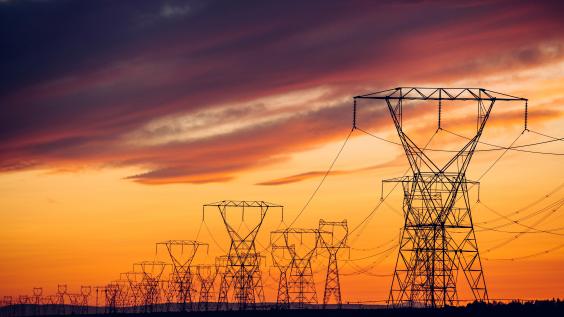
Table of Contents
Author(s)
Jim Krane
Wallace S. Wilson Fellow for Energy Studies | Co-Director, Middle East Energy RoundtableShih Yu (Elsie) Hung
Research Manager, Center for Energy StudiesShare this Publication
- Download PDF
- Print This Publication
- Cite This Publication Copy Citation
Krane, Jim and Shih Yu (Elsie) Hung. 2016. “Energy Subsidy Reform in the Persian Gulf: The End of the Big Oil Giveaway” Issue Brief no. 04.28.16. Rice University’s Baker Institute for Public Policy, Houston, Texas.
Introduction
Many thought it could never happen. The energy subsidy reforms that have gathered pace this year in the Persian Gulf monarchies were long considered to be impossible or illegitimate, violations of a state-society “social contract” in which welfare benefits are provided by the regime to buy public support. But since Dubai’s pathbreaking reform of 2011, the old hypotheses that said Gulf energy subsidies were sacrosanct1 have been overturned by the evidence
Energy subsidies have long outlived their usefulness. Energy products such as electricity and gasoline have been distributed domestically at low prices that, in some cases, have been fixed since the era of oil nationalization in the 1970s. Over time, government provision of cheap energy had the unintended consequence of encouraging high per capita demand. Recently governments in the Gulf monarchies have begun to challenge the notion that citizens are entitled to cheap energy. All six monarchies (Saudi Arabia, the United Arab Emirates, Kuwait, Oman, Qatar, and Bahrain) have raised prices on transportation fuel (see Table 1). Three have increased prices on electricity and water in citizens’ homes. Meanwhile, electricity and water subsidies for businesses have been reduced in five of the six monarchies. Across the Gulf, Iran has taken similar steps.
Table 1 — Fuel Price Changes, 2015–2016
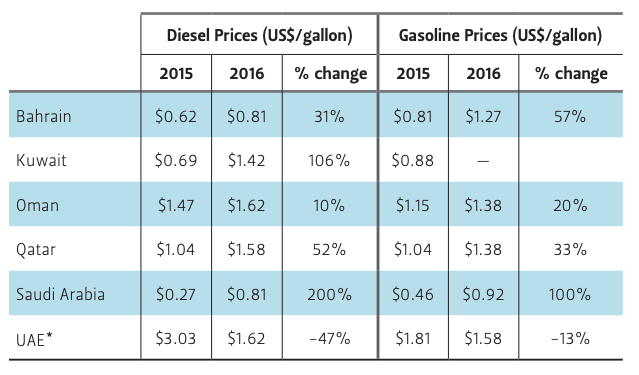
Source Rice University’s Baker Institute for Public Policy.
Policymakers hope higher energy prices can produce a number of helpful effects:
- Relieve pressure on government budgets at a time when oil and gas revenues are low
- Reduce domestic demand for oil and gas that can otherwise be exported
- Increase the relative attractions of non-carbon sources of energy
- Encourage conservation and efficiency, which helps reduce carbon emissions and the energy intensity of GDP while increasing overall productivity
Energy subsidy reforms also signal a change in state-society relations, at least in the way those relations are portrayed by political scientists. Since subsidies and other state benefits are deployed to build legitimacy for autocratic regimes, they are considered politically risky to retract. Increased energy prices have caused unrest in other oil-exporting countries.
However, the Gulf experience (at the time of writing) has gone smoothly. Most price increases have been modest and most energy products remain heavily subsidized and among the world’s cheapest. But political leaders have warned that further increases are likely. This brief presents a snapshot of the progress of subsidy reform in the Gulf, documenting policy changes in all six monarchies and briefly examining the role of energy and the state.
United Arab Emirates
The UAE emirate of Dubai was the first to reform citizens’ energy subsidies. In 2011, Dubai levied a 15% increase in electricity prices on all consumer categories, including the most politically sensitive, the citizen residential sector. The city began passing along part of the cost of LNG imported for use in power generation, but citizens were later exempted from these fees. Dubai also began charging citizens for high levels of residential water consumption. Previously, water had been free in unlimited quantities for citizens (see Figures 1 and 2).
Figures 1 and 2 — Change in Dubai Residential Electricity and Water Prices, 2010–2011
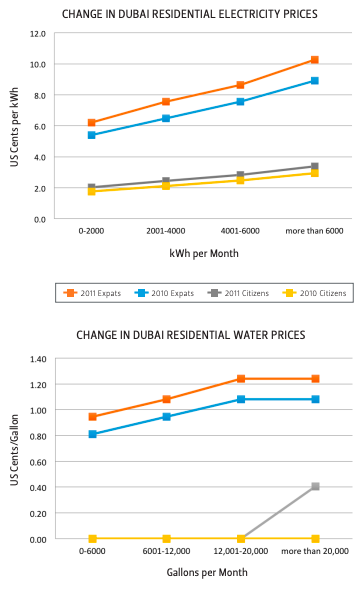
Expatriates in Dubai had already undergone numerous increases in electricity and water tariffs. By 2011 the city’s expatriate majority was cross-subsidizing citizens by paying rates about four times as high as those of UAE nationals. The subsidy reform was one of the austerity measures imposed in the wake of the 2009 financial crisis, which hit Dubai hard.2 Residents began complaining about high electricity bills when LNG surcharges were imposed during the peak summer demand season. The Dubai ruler made three separate retractions of parts of the tariff reform, all of which affected only citizen residential customers. The ruler rolled back electricity prices for low-income households, doubled the free water quota to 20,000 gallons per month,4 and agreed to pay citizens’ LNG surcharges. Despite these retractions, Dubai’s 15% increase in electricity tariffs stayed in place for the majority of citizens.
By the end of 2011, the rate increase is said to have reduced power consumption by an average of 3% per account and water consumption by an average of 7.2%. The tariff hike saved Dubai the equivalent of around six shipments of LNG that year, worth some US$300 million at prevailing prices.5 In August 2015, the UAE government in Abu Dhabi decided to fully abolish subsidies on transportation fuels, allowing prices to fluctuate monthly based on world benchmarks. The fuel price adjustment resulted in reduced prices for diesel, since the reform came alongside falling crude oil prices (see Figure 3).
Figure 3 — Monthly Changes in UAE Fuel Prices
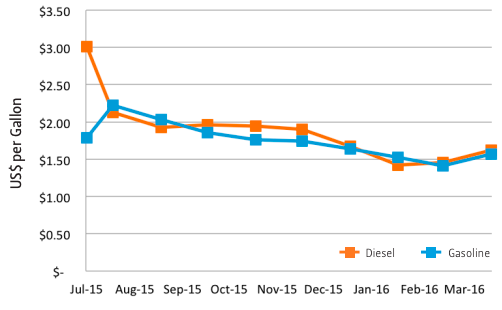
Abu Dhabi also increased water and electricity prices. The biggest increases were handed to foreign residents, who were already paying rates triple those of citizens. Abu Dhabi nationals received tiny increases in electricity charges and a modest rise for water, which, like in Dubai, had been free in unlimited quantities. Water tariffs for expatriates and government buildings rose to six times the level charged to citizen households: US$2.85 per 1,000 liters for foreigners, versus 46 US cents for citizens. The UAE’s two remaining utilities, in Sharjah and the northern emirates, have also raised prices, but only on foreign residents and industrial and commercial customers.6
Saudi Arabia
Saudi Arabia generates more than half its electricity by burning expensive oil and diesel fuel because natural gas is in short supply. With demand forecast to double over the coming decade, authorities increased prices to encourage consumers to adopt efficiency measures. An electricity price increase in 2010 raised rates on commercial and industrial customers.7 In 2016, residential customers received rate increases for the first time. However, the residential increase only affected higher consumption brackets (see Figure 4).
Figure 4 — Change in Saudi Residential Electricity Price, 2015–2016
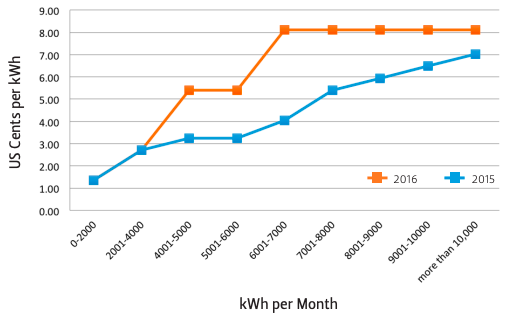
Most of the Saudi price reforms were aimed at commercial and industrial energy consumers. Commercial and industrial electricity prices increased at all tiers of consumption.8 Saudi Arabia also raised prices on gasoline, diesel, crude oil, and bulk natural gas by an average of 122%. As Table 2 shows, most prices remain well below international benchmarks.
Saudi Arabia also imposed big increases in water prices, which for the average household rose by more than 400% (see Figure 5). Complaints flooded into social media, triggering a government response in which the minister of water and electricity was fired. At the time of writing, the increased prices had not been changed.
Table 2 — Price Changes on Saudi Energy Products
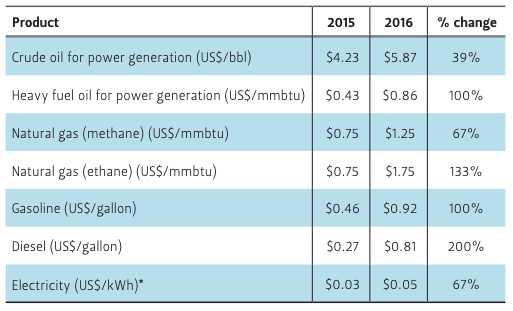
Source MEES and Saudi Electricity Company.
In 2015, Deputy Crown Prince Muhammad bin Salman announced his intention to fully rationalize energy prices, removing subsidies for higher-income Saudis and raising prices to international levels over the next five years (Friedman 2015; The Economist 2016). In 2012, the Ministry of Social Affairs began paying for the “reasonable” residential consumption of low-income Saudis, so that higher rates would not burden the poor.9
Saudi subsidy reform has been aided by high-profile warnings from Oil Minister Ali al-Naimi and his deputy, Prince Abdul-Aziz bin Salman, that the kingdom’s oil exports were threatened by growing domestic energy demand. Al-Naimi called for “a highly efficient rationalization program with the participation of the public and private sectors and all citizens in order to reduce consumption.”10 Officials hope that increased prices reduce wasteful practices.
Figure 5 — Change in Saudi Water Prices, 2015–2016
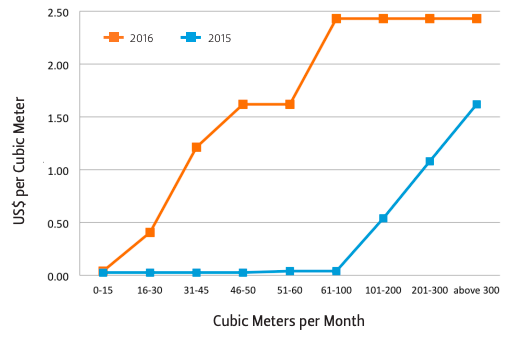
Saudi subsidy reform triggered an outpouring of comments on Twitter. Several critics argued that subsidy cuts were the result of economic mismanagement. They maintained that poor Saudis were being forced to underwrite questionable weapons purchases, wars in Syria and Yemen, and aid for Egypt’s military. Government corruption and royal family privilege is a key thread. “When oil went up to $120 a barrel, what did the general population gain? How can we justify increasing the cost burden on the public today? Whoever fails to properly manage these affairs should resign.”11
Others supported the reform. One commentator argued that subsidies amounted to an injustice because they accrue to those rich enough to capture them. “Imagine if the government decided to give a billion riyals to citizens, but 80% of this billion goes to the richest 40% of the population and the remaining 20% share goes to the poorer majority. Right now that is exactly what is happening under the current subsidy system. We are taking from the poor to give to the rich.”12
Kuwait
Kuwait is also under pressure to reform energy pricing. Rising demand for electricity has diverted ever-larger amounts of crude oil into the power sector, and has led the country to begin importing LNG at world market prices. Even so, electricity prices in Kuwait are among the world’s lowest, just 0.7 US cents per kilowatt-hour (kWh). Electricity payments covered just 5% of the government’s cost in providing power in 2011.13 In January 2016, the Kuwaiti government proposed a means-tested electricity price that would restrict the fully subsidized rate to just 12% of the population. The wealthiest would pay 4 US cents per kWh, which still amounts to about a third of the unsubsidized cost.14 Several parliamentarians have pledged to fight any price increase.
Despite the opposition, Kuwait succeeded in raising prices on diesel fuel. In January 2015, the longtime price of diesel of 69 US cents per gallon initially jumped to US$2.15, but within a month parliamentary pressure led to the price being readjusted to US$1.42/gallon. Further, the government gave permission for businesses with “heavy demand,” to continue paying the original diesel price of 69 US cents per gallon.15
Qatar
The only Gulf monarchy with cheaper electricity than Kuwait is Qatar, where, for citizens, it is free. For expatriate residents who dominate the population, however, electricity prices have risen twice over the past decade. In October 2015, electricity prices for foreigners rose from 2.16 to 2.43 US cents per kWh for consumption between 2,000 and 4,000 kWh. Prices rose even higher for larger rates of consumption. Water charges jumped from US$1.20 to at least US$1.50 per cubic meter for consumption beyond 20 cubic meters per month.16
For Qatari citizens, electricity and water will probably remain free. The country is a major producer of natural gas, only 7% of which is consumed in the power sector. Eighty percent is exported.17 With an absolute monarch dependent on citizen support, Qatar appears comfortable giving citizens unlimited18 free utility services.
Elsewhere, Qatar has managed to raise transportation fuel prices, reducing subsidies for all customers including Qatari nationals. In 2014, diesel prices rose from US$1.04 to US$1.58 per gallon19 while gasoline increased by 30%, from US$1.04 to US$1.38 per gallon.20 In 2016, Qatar has pledged to link fuel prices to international benchmarks.
Oman
Oman was the last of the Gulf monarchies to be electrified, starting in the 1970s. Since then, consumption has grown quickly. Oman’s electricity regulator has warned that subsidies encouraged an energy-inefficient building boom at a time when the country’s supply of natural gas was growing more costly.21 However, the onset of Arab Spring unrest made policymakers cautious about antagonizing citizens with higher prices.
Regardless, economic necessity has forced Oman to act. In 2015, the sultanate doubled natural gas prices to US$3 per million BTUs, while calling for further yearly increases of 3% going forward. This year, Oman increased prices for water, gasoline, and diesel fuel. Water prices were left as-is for the residential sector, but those for the government, commercial, and industrial sectors rose by 17%.22
Oman also put commercial and industrial customers on notice that electricity prices would increase. The politically sensitive residential sector appears likely to be insulated from any increase.23
Gasoline prices increased 20% to US$1.15 per gallon and diesel rose by 10% to US$1.62 per gallon. Oman plans to review prices monthly, similar to the neighboring UAE.24
Oman’s oil and gas minister, Mohammed bin Hamad al-Rumhy, remains among the region’s most vocal advocates for subsidy reform. "We are wasting too much energy in the region and the barrels that we are consuming are becoming a threat now, for our region particularly,” he said publicly in 2013. “What is really destroying us right now is subsidies” (Fineren 2013).
Bahrain
The island kingdom of Bahrain also launched a series of subsidy reforms in March 2016 targeting electricity, water, and transportation fuel. As in many neighboring states, citizens were exempt from increased rates while less-influential expatriate residents and commercial users bore the brunt. Water and electricity prices for non-citizens are to increase every year until they reflect the actual costs of electricity and water, around 2019.25 Since utility prices for citizens will not change, expatriate residents will effectively cross-subsidize the consumption of Bahraini nationals (see Figures 6 and 7).
Figures 6 and 7 — Proposed Change in Bahrain Residential Electricity and Water Prices
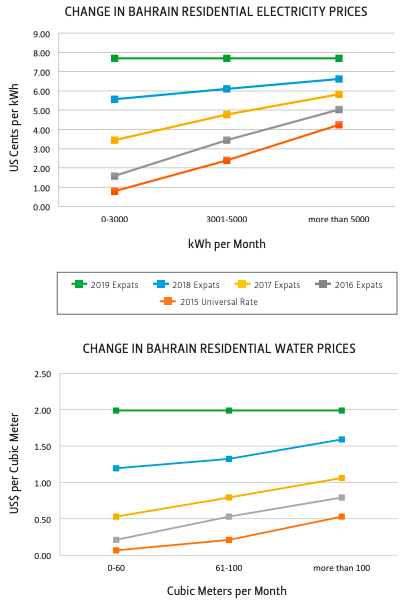
Conclusion
While energy prices remain low in most of the Gulf, and the biggest price increases have been levied on vulnerable expatriates and businesses, citizens have been told to pay more, including—in a few countries—in their own homes. Taking away citizen subsidies is a problematic outcome for political theory, which has long claimed that subsidies were untouchable elements of a state-society social contract. Numerous authors argued that such benefits were the chief inducements for citizens to put their support behind unelected autocrats. However, despite some grumbling and incremental backsliding in Dubai and Kuwait, the increased prices have held. Authors differ on the importance of these policy changes. On the one hand, political scientist JeanFrançois Seznec has described the possible “end to the rentier state in Saudi Arabia.”28 On the other, energy policy expert Jim Krane argues that energy prices had to be reformed to allow the state to maintain its other benefit obligations over the long term (Krane 2015).
Either way, the cautious nature of these reforms demonstrates that the monarchies remain deferential to the wishes of their citizens, who have been shielded from the brunt of the reform. The state remains wary of antagonizing people who possess new communication tools aiding mobilization. Saudi Crown Prince Muhammad bin Salman has said that social contract allocations cannot be changed without the consent of notable citizens. “The king cannot just wake up and decide to do something,” he said (Friedman 2015).
Endnotes
1. Numerous authors describe subsidies as “rights of citizenship” in rentier systems like those in the Gulf monarchies. See, for example, Beblawi and Luciani 1987; Crystal 1990; Farsoun 1988; Gause III 1994; Herb 1999; Okruhlik 1999; Schlumberger 2006, among others.
2. Author Jim Krane, multiple interviews with Dubai officials who spoke on condition of anonymity, 2011-13.
3. 2010 tariff retrieved from “Dubai residents complain of hikes in water, electricity tariffs,” Gulf News, October 19, 2011.
4. Media Office for Sheikh Mohammed bin Rashid al-Maktoum, 2011. Some customers never received an increase. These include households headed by members of the security services, or important tribal or ruling family members.
5. Author Jim Krane, interviews with energy policy officials in Dubai government, 2012 and 2013.
6. Sharjah Electricity and Water Authority (SEWA) raised electricity and water rates for industrial and commercial users in 2014, but left residential rates unchanged. See “No power shortage in Sharjah: Sewa chief,” Emirates 24/7, March 29, 2016; “Fewa bills increase by 5 fils per kw/h,” Gulf News, December 15, 2014.
7. “Saudi Arabia excludes homes from increased power prices,” Gulf News, June 6, 2010.
8. Prices increased from 12 halala (US$0.03) to 16 halala (US$0.04) per kWh for commercial users and to 18 halala (US$0.05) per kWh for industrial users.
9. Author Jim Krane, interview with Abdullah M. al-Shehri, governor of Electricity & Co-Generation Regulatory Authority of Saudi Arabia, Dhahran, October 21, 2012.
10. See, for example, Dourian 2012.
11. Ali al-Ali, Twitter post, January 1, 2016, http://www.twitter.com/alialali26, translated from Arabic.
12. Essam al-Zamel, “Removal of subsidies on gasoline, diesel and electricity prices. Is it in the interest of the citizen and the economy?” YouTube video commentary, January 3, 2016.
13. Electricity tariff and cost details from Kuwait Ministry of Electricity and Water, March 2012.
14. Citing Ministry of Electricity and Water Undersecretary Mohammad Bushahari. See “Decision to Raise Prices of Fuel Pushed Back Six Months,” Arab Times (Kuwait), January 7, 2016.
15.“Kuwait cuts diesel fuel prices after political pressure,” Reuters, January 28, 2015.
16. “Qatar’s Kahramaa hikes water, electricity tariffs,” NRICafe, October 14, 2015.
17. See International Energy Agency, 2012.
18. Qatari households receive unlimited free electricity in their primary residence. Citizens are technically required to pay for electricity at secondary homes unless the residence is home to a Qatari man’s second wife.
19. “30% to 50% hike in Qatar petrol prices from Friday,” Gulf Times, January 14, 2016.
20. “Qatar to hike petrol prices by more than 30 per cent,” The National, January 15, 2016.
21. Author Jim Krane, interview with John Cunneen, executive director, Authority for Electricity Regulation, Muscat, Oman, November 15, 2011.
22. From US$0.007 to US$0.009 (3 to 3.5 Omani baiza) per gallon. “Oman’s Public Authority for Electricity and Water announces hike in water tariffs,” Times of Oman, March 15, 2016.
23. “Oman plans 7-8% cut in electricity subsidies,” Reuters, March 3, 2016.
24. “Petrol price hike: Oman to fall from ninth cheapest fuel in world to 13th,” Times of Oman, January 11, 2016.
25. “New Tariff for Water & Electricity,” Hello Bahrain, January 15, 2016.
26. “Bahrain approves ‘gradual’ increase of diesel prices,” Trade Arabia, December 28, 2015.
27. “Bahrain natural gas prices for industry rise 25 cents per mmBtu—agency,” Reuters, January 30, 2015.
28. Jean-François Seznec, “Saudi Energy Changes: The End of the Rentier State?” March 24, 2016, The Atlantic Council.
References
Beblawi, Hazem, and Giacomo Luciani. 1987. “Introduction.” In The Rentier State, edited by Hazem Beblawi and Giacomo Luciani. London: Croon Helm.
Crystal, Jill. 1990. Oil and Politics in the Gulf: Rulers and Merchants in Kuwait and Qatar. Cambridge: Cambridge University Press.
Dourian, Kate. 2012. “Saudi Arabia Warns Domestic Oil Use Growing at ‘Frightening Level.’” Platts, November 26.
Farsoun, Samih K. 1988. “Oil, State, and Social Structure in the Middle East.” Arab Studies Quarterly: 155–75.
Fineren, Daniel. 2013. “Oman Oil Minister Slams Gulf Culture of Energy Subsidies.” Reuters, November 10.
Friedman, Thomas L. 2015. “Letter From Saudi Arabia.” The New York Times, November 25: A31.
Gause III, F. Gregory. 1994. Oil Monarchies: Domestic and Security Challenges in the Arab Gulf States. New York: Council on Foreign Relations.
Herb, Michael. 1999. All in the Family: Absolutism, Revolution, and Democracy in Middle Eastern Monarchies. Albany: SUNY Press.
International Energy Agency. 2012. “Electricity Information and Natural Gas Information.” Statistics database Paris: IEA.
Krane, Jim. 2015. “Stability versus Sustainability: Energy Policy in the Gulf Monarchies.” The Energy Journal 36, no. 4.
Okruhlik, Gwenn. 1999. “Rentier Wealth, Unruly Law, and the Rise of Opposition: The Political Economy of Oil States.” Comparative Politics 31, no. 3: 295–315.
Schlumberger, Oliver. 2006. “Rents, Reform, and Authoritarianism in the Middle East.” In Dead Ends of Transition, edited by Michael Dauderstadt and Arne Schildberg. Frankfurt: Campus Verlag.
The Economist. 2016. “Transcript: Interview with Muhammad Bin Salman.” January 6.
This material may be quoted or reproduced without prior permission, provided appropriate credit is given to the author and Rice University’s Baker Institute for Public Policy. The views expressed herein are those of the individual author(s), and do not necessarily represent the views of Rice University’s Baker Institute for Public Policy.


